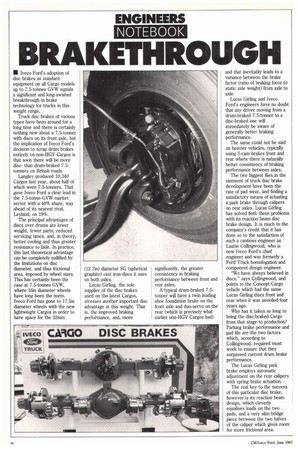BRAKETHROUGH
Page 112

If you've noticed an error in this article please click here to report it so we can fix it.
• Iveco Ford's adoption of disc brakes as standard equipment on all Cargo models up to 7.5-tonnes GVW signals a significant and long-awaited breakthrough in brake technology for trucks in this weight range.
Truck disc brakes of various types have been around for a long time and there is certainly nothing new about a 7.5-tonner with discs on its front axle, but the implication of Iveco Ford's decision to scrap drum brakes entirely on non-HGV Cargos is that soon there will be more discthan drum-braked 7.5tonners on British roads.
Langley produced 10,240 Cargos last year, about half of which were 7.5-tonners. That gave lveco Ford a clear lead in the 7.5-tonne-GVW market sector with a 40% share, way ahead of its nearest rival, Leyland, on 19%.
The principal advantages of discs over drums are lower weight, fewer parts, reduced servicing times, and, in theory, better cooling and thus greater resistance to fade. In practice, this last theoretical advantage can be completely nullified by the limitations on disc diameter, and thus frictional area, imposed by wheel sizes. This has certainly been the case at 7.5-tonnes GVW, where 161n diameter wheels have long been the norm. Iveco Ford has gone to 17.5in diameter wheels with the new lightweight Cargos in order to have space for the 32mm (12.7in) diameter SG (spherical graphite) cast iron discs it uses on both axles.
Lucas Girling, the sole supplier of the disc brakes used on the latest Cargos, stresses another important disc advantage at this weight. That is, the improved braking performance, and, more significantly, the greater consistency in braking performance between front and rear axles.
A typical drum-braked 7.5tonner will have a twin leading shoe foundation brake on the front axle and duo-servo on the rear (which is precisely what earlier non-HGV Cargos had) and that inevitably leads to a variance between the brake factor (ratio of braking force to static axle weight) from axle to axle.
Lucas Girling and Iveco Ford's engineers have no doubt that any driver moving from a drum-braked 7.5-tonner to a disc-braked one will immediately be aware of generally better braking performance.
The same could not be said on heavier vehicles, typically using S-cam brakes front and rear where there is naturally better consistency of braking performance between axles.
The two biggest flies in the ointment of truck disc brake development have been the rate of pad wear, and finding a satisfactory means of actuating a park brake through calipers on rear axles. Lucas Girling has solved both these problems with its reaction beam disc brake design. It is much to the company's credit that it has done so to the satisfaction of such a cautious engineer as Laurie Collingwood, who is now Iveco Ford's chief engineer and was formerly a Ford Truck homologation and • component design engineer.
"We have always believed in discs," says Collingwood, and points to the Concept Cargo vehicle which had the same Lucas Girling discs front and rear when it was unveiled four years ago.
Why has it taken so long to bring the disc-braked Cargo from that stage to production? Parking brake performance and pad life are the two factors which, according to Collingwood, required most work to ensure that they surpassed current drum brake performance.
The Lucas Girling park brake employs automatic adjustment on the rear calipers with spring brake actuation.
The real key to the success of this particular disc brake, however is its reaction beam design, which cleverly equalises loads on the two pads, and a very slim bridge piece between the two halves of the caliper which gives room for more frictional area.
























































































































